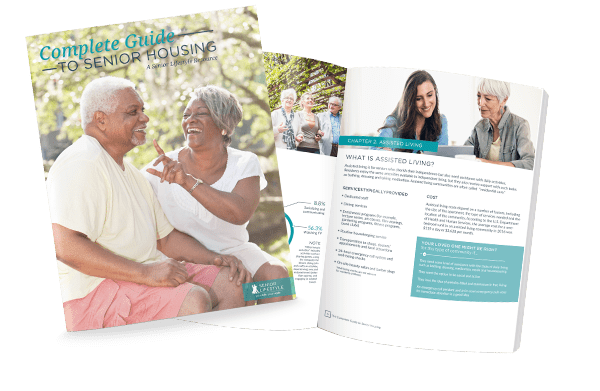Moving into a senior living community can be a significant life transition, and downsizing is often a crucial step in the process. Downsizing can feel overwhelming, especially if you’ve accumulated possessions over many years.
However, with careful planning and organization, it can also be a freeing experience, allowing you to simplify your life and focus on the things that matter most.
Here are eight senior downsizing tips to help make the transition to a retirement community smoother:
1. Start Early
Beginning the downsizing process well in advance of your move is crucial for several reasons.
First, it allows you ample time to sort through your belongings thoughtfully, without feeling rushed or overwhelmed. This extra time also gives you the opportunity to make careful decisions about what to keep, donate, or discard, rather than hastily making choices you may later regret. Additionally, starting early provides a buffer for unexpected challenges or delays that may arise during the downsizing process.
By giving yourself plenty of time, you can approach the task with a sense of calm and purpose, rather than feeling stressed or pressured.
2. Create a Plan
Developing a clear plan of action for how you’ll tackle the downsizing process is essential for staying organized and focused.
Start by breaking the process down into manageable steps. Set realistic deadlines for each step of the process to help you stay on track and motivated. Consider creating a checklist or timeline to keep yourself accountable and ensure that no task gets overlooked.
Having a plan in place will give you a sense of direction and purpose as you work toward your goal of downsizing.

Download The Complete Guide to Senior Housing
Every senior has their own set of wants and needs, so retirement communities offer differing levels of care, services, and amenities. Read our eBook for a detailed look at what retirement communities provide.
Download the Guide3. Take Inventory
Before you begin purging belongings, it’s helpful to take inventory of what you have. This involves systematically cataloging and documenting the items in your home, either manually or using digital tools.
This move not only helps you keep track of your belongings but also allows you to make informed decisions about what to keep, donate, or discard. As you go through each item, consider factors such as its sentimental value, practicality, and whether it aligns with your lifestyle in your new living space.
Taking inventory provides a solid foundation for the downsizing process and ensures that you’re making intentional choices about what to keep and what to let go of.
4. Declutter Room by Room
Instead of trying to tackle your entire home at once, take a systematic approach to decluttering by focusing on one room at a time.
Start with less sentimental areas like storage closets, utility rooms, or the garage, where decision-making may be easier. As you progress, gradually move on to more sentimental spaces like bedrooms, living areas, and home offices. Decluttering room by room also allows you to visualize the impact of your efforts and stay motivated as you work toward your goal of downsizing.
By breaking the downsizing process down into smaller, more manageable tasks, you can prevent yourself from feeling overwhelmed and maintain a sense of progress and accomplishment.
5. Use the Four-Box Method
When sorting through your belongings, employing the four-box method can provide structure and clarity to the process.
As you go through each item, designate it to one of four categories: keep, donate, sell, or discard. This method helps streamline decision-making and prevents indecision or procrastination. Be deliberate and honest in your choices, considering factors such as the item’s usefulness, sentimental value, and whether it aligns with your new lifestyle in the senior living community.
By categorizing items into distinct boxes, you can maintain momentum and make tangible progress toward your downsizing goals.
6. Downsize Sentimentally
Sentimental items often pose the greatest challenge when downsizing, as they carry emotional significance and memories. However, it’s essential to approach this process with intentionality and discernment.
Rather than holding onto every sentimental item, focus on preserving those that hold the most meaning or bring you genuine joy. Consider taking photographs of sentimental items you’re parting with, creating a digital archive of memories that you can revisit whenever you wish.
By prioritizing the most meaningful items, you can honor your past while embracing the opportunity to create a lighter, more curated living space for your future.
7. Digitize Documents and Photos
Paperwork and photographs can accumulate over the years, taking up valuable space in your home. To reduce clutter and preserve important memories, consider digitizing your documents and photos.
There are numerous apps and services available that make this process simple and convenient. Scan important documents, such as financial records, legal documents, and medical records, and store them securely on your computer or in the cloud. Similarly, digitize old photographs and albums to create a digital archive of cherished memories.
Not only does digitization save physical space, but it also ensures that your valuable documents and memories are safely preserved for years to come.
8. Have Fun!
Downsizing doesn’t have to be a daunting or stressful task—it can also be an opportunity for adventure and discovery.
Approach the process with a positive mindset and a sense of curiosity. Use this time to revisit cherished memories, rediscover forgotten treasures, and envision the possibilities of your new living space. Consider involving friends or family members in the downsizing process, turning it into a social activity or a trip down memory lane. Celebrate each milestone and accomplishment along the way, recognizing the progress you’ve made and the new opportunities that await.
By infusing the downsizing process with joy and enthusiasm, you can transform it from a chore into a rewarding and empowering experience.
Move Into a Safe, Happy Community at Senior Lifestyle
Moving into a senior living community is a new chapter in life, and downsizing is an essential part of that transition. By starting early, creating a plan, and following these senior downsizing tips, you can streamline the downsizing process and make your move a smoother and more positive experience.
Remember, downsizing isn’t just about letting go of possessions; it’s about creating a space that reflects your new lifestyle and priorities. And at Senior Lifestyle, you’ll be able to enjoy that new life while we take care of your everyday needs, such as cleaning and cooking.
Find out more about Senior Lifestyle or schedule a visit today.

